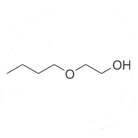What is Butyl Glycol?
Butyl glycol (also known as BG, 2-butoxyethanol, glycol monobutyl ether and ethylene glycol monobutyl ether, butyl cellosolve, butoxyethanol) is a clear, colourless, oily liquid with a unique sweet yet mild odour and has the formula C6H14O2. It is a butyl ether of ethylene glycol and is miscible with water and common organic solvents. It has been produced industrially for over half a century and is used primarily as a solvent in paints and surface coatings but also in inks and cleaning products.

Technical Properties
Chemical and physical properties of butyl glycol:
Molecular Formula: C6H14O2 / CH3(CH2)2CH2OCH2CH2OH
Synonyms: 2-Butoxyethanol, Butyl Cellosolve, Butyl Monoether Glycol, Ethylene Glycol Monobutyl Ether (EGBE), Butoxyethanol
Cas Number: 111-76-2
Molecular Mass: 118.176 g/mol1
Exact Mass: 118.09938 g/mol
Flashpoint: 153 °F / 67 °C
Boiling Point: 340 °F / 171 °C
Melting Point: -107 °F / -77 °C
Vapour Pressure: 0.76 mm Hg at 68 ° F
Water Solubility: ≥ 100 mg/ml (72° F)
Density: 0.90 g/cm3
Log P: 0.83
How is it Produced?
Butyl glycol is produced by reacting ethylene oxide with an alcohol such as normal butanol (nbutanol) within a catalyst. This process is called ethoxylation. If the ratio of ethylene oxide to nbutanol is greater than one then di- and tri- ethylene glycol monoethers are also produced.
Below is the chemical equation for this reaction:
C2H4O + C4H9OH → C4H9OC2H4OH
World production is estimated at between 300-500 KT per annum. Butyl glycol can also be produced through the etherification of butanol with 2-chloroethanol.
How is it Handled, Stored and Distributed?
Butyl glycol is classed as an irritant, therefore, great precaution and care must be taken during the handling and distribution process.
Hazards
Butyl glycol, if in contact with your eyes, skin, throat, can be harmful and cause serious irritation. Ingestion, and skin contact, can produce headaches, nausea, and dizziness. The wearing of PPE equipment is recommended to prevent the chances of skin content, swallowing and inhaling.
If contact is made, it should be immediately washed out of eyes, soapy water should be used to clean the skin and any clothing contacted should also be removed and replaced. Medical support must be obtained in all circumstances, especially if the chemical is swallowed.
It has a National Fire and Protection Association health rating of 3, indicating that it can cause serious and even permanent injuries in critical conditions. A fire rating of 2 indicates that a modest amount of high heat exposure is required for ignition to ensue; a flame or spark will easily cause an ignition.
Visit Cameo Chemicals for more details.
Storage & Distribution
Butyl glycol should be stored in a cool, dark place away from food and oxidants. It is transported in carbon steel, stainless steel or teflon containers and can be moved in bulk or drums. It has a specific gravity of 0.9 and a flashpoint of 60 °C (closed cup) and has been classified as harmful but is not classified as dangerous for any form of transport.
If a leak or spillage has occurred, it should be immediately isolated (up to 50 meters in a 360 angle) and the source should be eliminated (only if possible, without risk). Personal protection equipment must be worn, specifically a respirator to filter out gases emitted from the spillage.
The leak should be soaked up by a non-combustible material such as earth and then collected in sealable containers. Wash away remainder with water. If it is a minor leak, then a more common approach can be taken including the use of kitchen towel. This should then be burned away from the spillage. The area must then be ventilated to ensure all vapours and gases are eliminated.
How is Butyl Glycol Used?
Butyl glycol has many uses, primarily as a solvent, in both the commercial and industrial industries.
Industry Uses
Butyl glycol usage is dominated by the paint industry which consumes approximately 75 % of all the BG produced. This is because it is a low volatility solvent and can therefore both extend the drying times of coatings and improve their flow.
Other applications include use as a solvent in printing inks due to its high boiling point, textile dyes and as a component of hydraulic fluids. It is also a component of drilling and cutting oils and is a major component of Corexit 9527, which is an oil spill dispersant product.
It is also a chemical intermediate and, as such, is a starting material in the production of butyl glycol acetate which is, itself, an excellent solvent. It is also a starting material in the production of plasticisers by the reaction of phthalic anhydride.
Commercial Uses
Butyl glycol is used regularly in most households as it is a component of many home cleaning products. It provides excellent cleaning power for domestic cleaning products and also provides the characteristic odour that we associate with them. It also plays the same role in some industrial and commercial surface cleaners.
Many other products contain butyl glycol including spray lacquers, varnishes, varnish removers, paints, liquid soaps, degreasers, leather protectors, whiteboard cleaners, printing pastes, enamels, cosmetics and herbicides.
For more details on our Butyl Glycol or if you would like to chat to one of our team, please contact our UK office on 44+(0)1483 203224, our Antwerp office on +32 03 205 16 66 or visit our contact us page.



